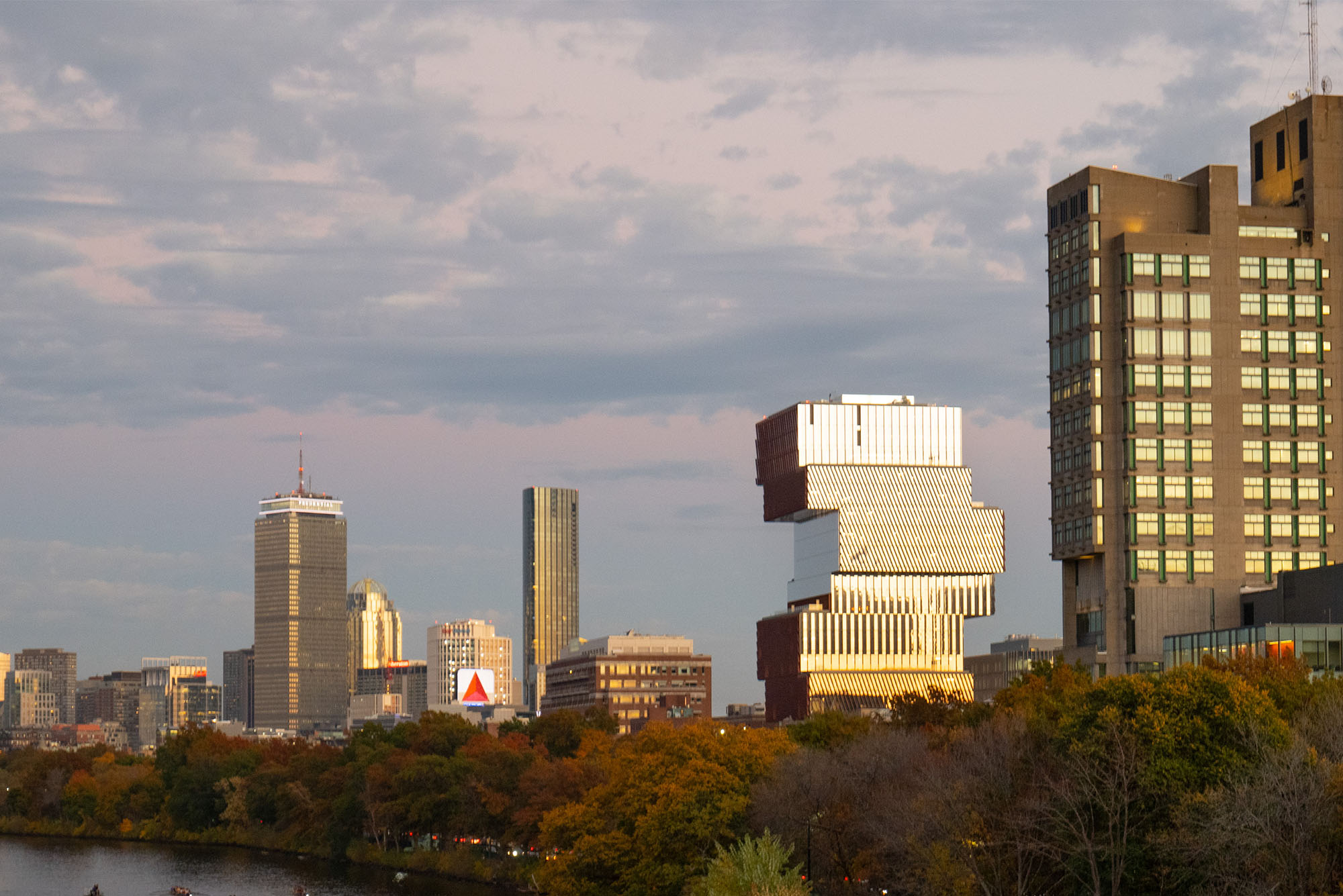Smithsonian Channel to Air Segment on BU’s Center for Computing & Data Sciences
Sunday night’s episode of How Did They Build That? explores building’s architecture and sustainability

BU’s Center for Computing & Data Sciences is the subject of a new episode of the Smithsonian Channel show How Did They Build That? Photo by Julian Massari (ENG’26)
Smithsonian Channel to Air Segment on BU’s Center for Computing & Data Sciences
Sunday night’s episode of How Did They Build That? explores building’s architecture and sustainability
Have you ever looked at BU’s Center for Computing & Data Sciences and wondered why it doesn’t tip over? Or why it’s described as fossil fuel–free? Then you’ll want to tune into the Smithsonian Channel on Sunday at 9 pm for a quick explainer.
CDS stars in the newest episode of How Did They Build That? a show that explores the most architecturally complicated buildings around the world and the features that make them so. Hosted by actor Jay Ellis (Top Gun), the show covers a range of topics, including towers, cantilevers, roofs, arches, biomes, hotels, opera houses, and seismic stations.
Sunday’s segment includes interviews with the architects, engineers, and BU staff who collaborated to make the 19-story, 345,000-square-foot CDS building one of the most eye-catching and sustainable in New England when it opened in January 2023. Designed by Toronto-based KPMB Architects and built by Boston-based Suffolk Construction, the CDS tower gets its striking profile from its massive cantilevered sections, often described as resembling a stack of books or a game of Jenga. As the city’s largest fossil fuel-free and carbon-free building, it’s one of the biggest components of BU’s Climate Action Plan, which aims to reduce the University’s carbon emissions to net zero by 2040.
These attributes made it a perfect subject for the Smithsonian show. From the How Did They Build That? website: “Each structure pushes a boundary—engineering, construction, materials, politics, etc.—and overcomes obstacles to become a standout star of the built environment. Meet architects, builders, and experts to get the inside scoop on: How did they build that?” Earlier episodes have featured a sky garden in Singapore, a bent copper-covered Manhattan skyscraper, and a mobile research station in Antarctica.
In June 2024, the How Did They Build That? production crew traveled to Boston to conduct interviews and film beauty shots of the building and Comm Ave.
Among those interviewed for the show is Dennis Carlberg, associate vice president for university sustainability and chief sustainability officer, who says on camera that requesting that CDS be a carbon-neutral building was a “bold request,” since no one had ever done it at this scale in Boston before. The LEED Platinum building integrates sustainable features such as green roofs, triple-glazed windows, and renewable energy systems. The building has no gas line connected and instead relies on geothermal heating and cooling (otherwise known as “ground source heat pumps”). This system is powered through 31 boreholes drilled 1,500 feet underneath the Earth’s surface to heat and cool the building.
“We were breaking new ground,” Carlberg says. “This is still the largest fossil fuel–free, carbon-neutral building in Boston. After a few years, we are beginning to see other large building developers follow BU’s lead [and] that is the best news if we are going to have a chance to reduce the impacts from our changing climate.”
This is the largest fossil fuel-free, carbon-neutral building in Boston. We are beginning to see other large building developers follow BU’s lead.
Azer Bestavros, BU associate provost for computing and data sciences, says he was delighted but not surprised that the building was chosen to be featured on the show, since “if they were going to have any building that would trigger that question [of how did they build that], it would be ours,” he says.
The building’s planning and construction took a decade, and since Bestavros could speak to the needs of the building and how it could best serve its tenants, he was in on the early discussions.
A William Fairfield Warren Distinguished Professor and a College of Arts & Sciences professor of computer science, Bestavros says since the building was designed for BU’s computing and data sciences teams—today it houses the Center for Computing & Data Sciences, the CAS mathematics and statistics and computer science departments, the Rafik B. Hariri Institute for Computing and Computational Science & Engineering, and BU Spark!—initial expectations might have been that the building would be “flashy” and highlight technology.
“But what I told the architect is exactly the opposite,” Bestavros says. “What I want is a building that highlights people because computer science is technology, it’s really about ideas, innovation, and people.”
To that end, there are whiteboards everywhere and lots of gathering and group meeting spaces, with no corner offices. He loves how its glass walls help it appear inviting from the street.
Asked if the building turned out the way he had hoped, Bestavros says it has been beyond his expectations. “When it opened the students came in and immediately started using the space,” he says. “You walk around and students are studying and chatting in every nook and corner. They have made it their home.”
How Did They Build That? airs Sunday, October 20, at 9 pm on the Smithsonian Channel, available on Paramount+ and some cable providers. It will also stream afterwards. Find out how to watch here.
Comments & Discussion
Boston University moderates comments to facilitate an informed, substantive, civil conversation. Abusive, profane, self-promotional, misleading, incoherent or off-topic comments will be rejected. Moderators are staffed during regular business hours (EST) and can only accept comments written in English. Statistics or facts must include a citation or a link to the citation.